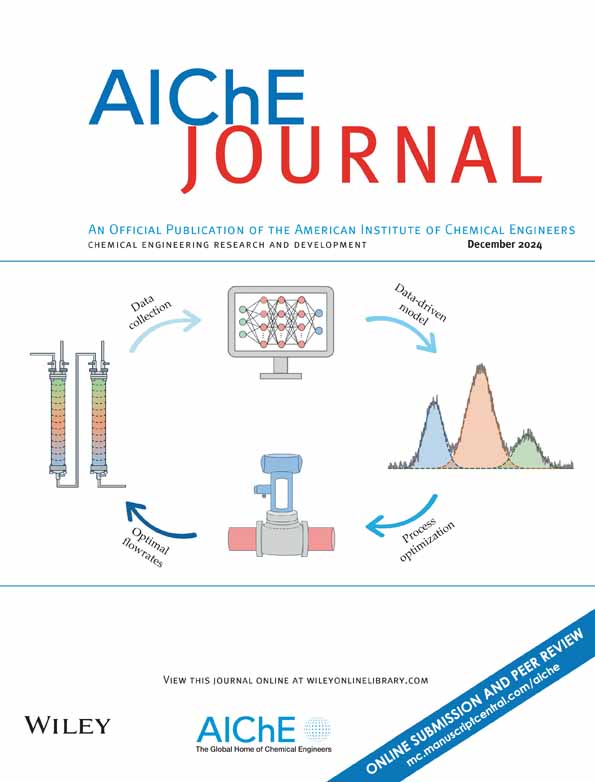Vapor‐liquid equilibrium, thermodynamic properties, process simulation and economic evaluation of CPME and methanol system
IF 3.5
3区 工程技术
Q2 ENGINEERING, CHEMICAL
引用次数: 0
Abstract
Cyclopentyl methyl ether (CPME) is a promising green solvent due to its eco‐friendly properties; it is produced by adding methanol (MeOH) to cyclopentene. Separation of the resulting product mixture containing CPME and MeOH is critical, and it requires vapor‐liquid equilibrium (VLE) data. In this work, isobaric VLE data were measured experimentally using an ebulliometer in a 60.0–101.3 kPa pressure range for a binary system of CPME + MeOH. VLE data were modeled using excess Gibbs (G) energy‐based models such as Wilson, NRTL, and UNIQUAC. The formation of an azeotrope was analyzed. Flash point, surface tension, Gibbs adsorption, and thickness of surface layer were estimated using the Wilson model, which can help in determining molecule interaction and overall behavior of the system. Atmospheric and high‐pressure distillation columns were designed using Aspen Plus to study the separation of CPME + MeOH, and an economic evaluation of the same was carried out.CPME和甲醇体系的汽液平衡、热力学性质、过程模拟和经济评价
环戊基甲基醚(CPME)是一种很有前途的绿色溶剂。它是通过在环戊烯上加入甲醇(MeOH)而制得的。含有CPME和MeOH的产物混合物的分离是至关重要的,它需要汽液平衡(VLE)数据。在这项工作中,我们用热膨胀计在60.0-101.3 kPa的压力范围内测量了CPME + MeOH二元系统的等压VLE数据。VLE数据采用基于过量吉布斯(G)能量的模型(如Wilson、NRTL和UNIQUAC)建模。分析了共沸物的形成过程。使用Wilson模型估计闪点、表面张力、吉布斯吸附和表面层厚度,这有助于确定分子相互作用和系统的整体行为。采用Aspen Plus设计常压精馏塔和高压精馏塔,对CPME + MeOH的分离进行了研究,并对其进行了经济评价。
本文章由计算机程序翻译,如有差异,请以英文原文为准。
求助全文
约1分钟内获得全文
求助全文
来源期刊

AIChE Journal
工程技术-工程:化工
CiteScore
7.10
自引率
10.80%
发文量
411
审稿时长
3.6 months
期刊介绍:
The AIChE Journal is the premier research monthly in chemical engineering and related fields. This peer-reviewed and broad-based journal reports on the most important and latest technological advances in core areas of chemical engineering as well as in other relevant engineering disciplines. To keep abreast with the progressive outlook of the profession, the Journal has been expanding the scope of its editorial contents to include such fast developing areas as biotechnology, electrochemical engineering, and environmental engineering.
The AIChE Journal is indeed the global communications vehicle for the world-renowned researchers to exchange top-notch research findings with one another. Subscribing to the AIChE Journal is like having immediate access to nine topical journals in the field.
Articles are categorized according to the following topical areas:
Biomolecular Engineering, Bioengineering, Biochemicals, Biofuels, and Food
Inorganic Materials: Synthesis and Processing
Particle Technology and Fluidization
Process Systems Engineering
Reaction Engineering, Kinetics and Catalysis
Separations: Materials, Devices and Processes
Soft Materials: Synthesis, Processing and Products
Thermodynamics and Molecular-Scale Phenomena
Transport Phenomena and Fluid Mechanics.
 求助内容:
求助内容: 应助结果提醒方式:
应助结果提醒方式:


